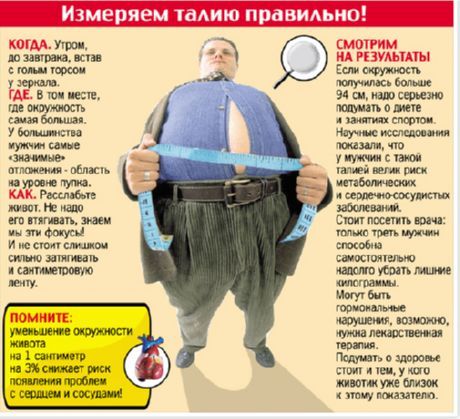
All iLive content is medically reviewed or fact checked to ensure as much factual accuracy as possible.
We have strict sourcing guidelines and only link to reputable media sites, academic research institutions and, whenever possible, medically peer reviewed studies. Note that the numbers in parentheses ([1], [2], etc.) are clickable links to these studies.
If you feel that any of our content is inaccurate, out-of-date, or otherwise questionable, please select it and press Ctrl + Enter.
Men with wide waists are more likely to suffer from urinary disease
Last reviewed: 01.07.2025
Men with a waist size of more than 100 cm urinate more often, say experts from Weill Cornell Medical College (USA).
The study included 409 men aged 40 to 91 years with moderate to severe lower urinary tract symptoms who had been patients at the Institute of Bladder and Prostate Health for the past two and a half years. 37.5% of the subjects had a waist circumference of less than 90 cm, 33.5% had a waist circumference of 90 to 99 cm, and 29% had a waist circumference of 100 cm or more. The participants were evenly distributed between the groups by age, with the exception of those aged 70 to 79, who were the most obese.

It turned out that men with a large waist urinated more often: 39% of participants in the heaviest group, 27% of those in the average group, and 16% of those with a normal waist relieved themselves more than eight times in 24 hours. A larger waist was also associated with visiting the toilet more than twice a night: 44% of obese men, 29% of those in the average group, and 15% of those who were relatively slender experienced this. Those with a large waist more often complained of problems with erection (74.5%, 50%, and 32%, respectively) and ejaculation (65%, 40%, and 21%, respectively).
The same trend was observed for high blood pressure (33.5, 22, and 14.5%), coronary heart disease (29, 17, and 8%), type 2 diabetes (33, 16, and 11%), and cholesterol (254, 176, and 148 mg/dL).
Having obtained this data, the scientists analyzed the connection between waist size and the increased risk of various urological, sexual, metabolic and cardiovascular problems. It turned out that the most obese were 39% more likely than others to encounter a problematic prostate, and the probability of an increased level of prostate-specific antigen was 111% higher in this group than in the rest.
What is the normal waist size for men and women?
For adult women of the Caucasian race, the maximum waist size is considered to be 80 cm. Figures within 80-87 cm indicate a health risk. Anything above 88 cm is a reason to seriously think about losing weight. For men, these limits look like this: up to 94 cm is normal, 94-101 cm is a risk, more than 102 cm is a high risk.
There is, however, another way to determine whether your figure fits within healthy limits. Moreover, compared to the “centimeter” method, it is considered more reliable - after all, what is normal for a tall person may be too much for someone who is shorter. And by the way, you will not need any improvised means. Just stand up straight and pinch the fat fold on your stomach with two fingers. If its thickness is 2 cm or less, there is nothing to worry about. If it is more, start preparing for a diet.
